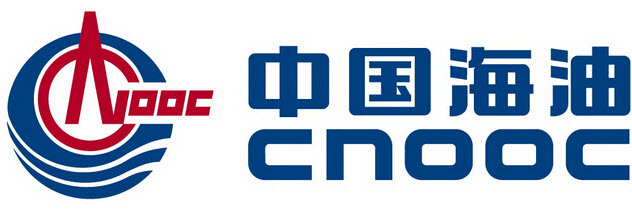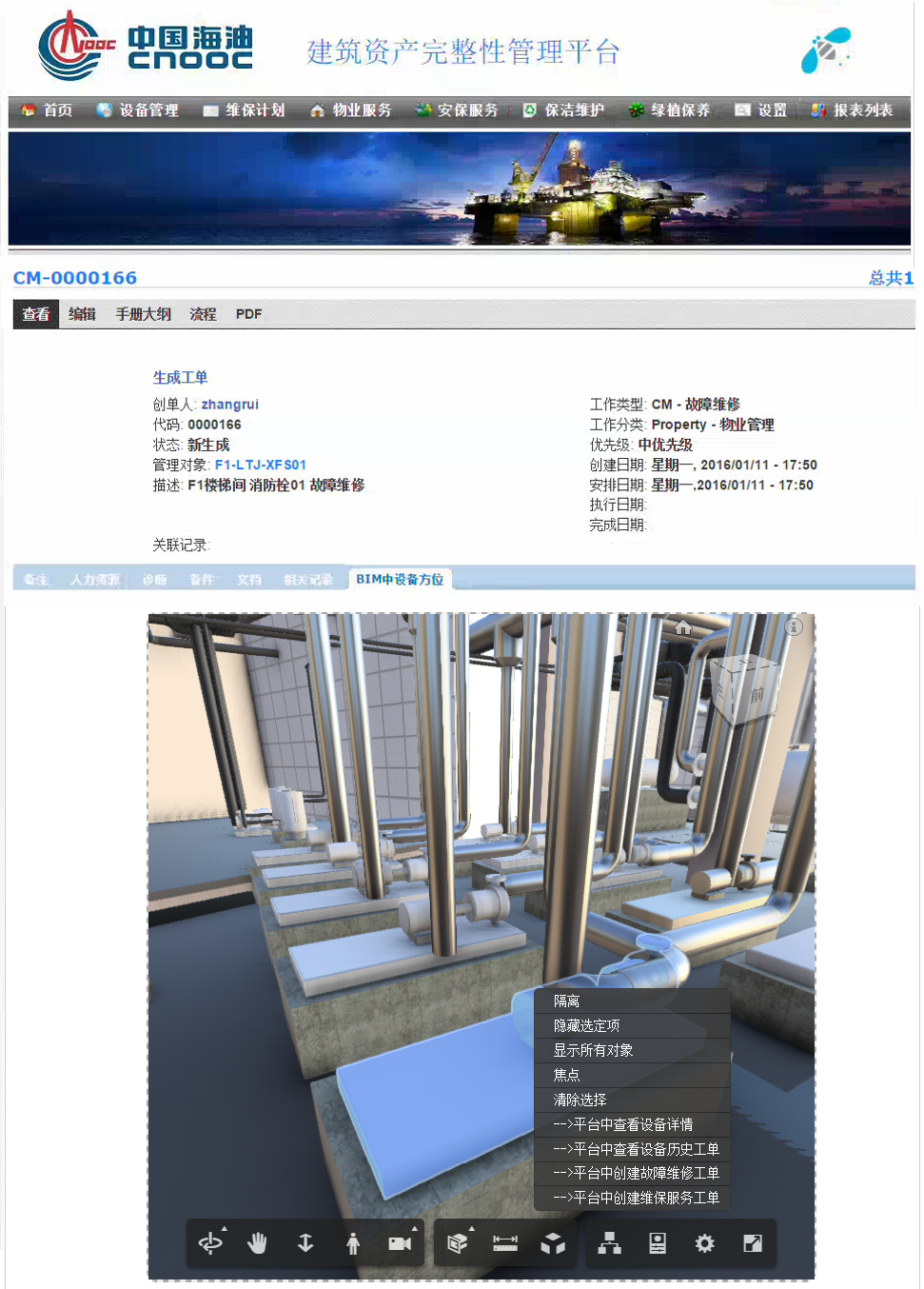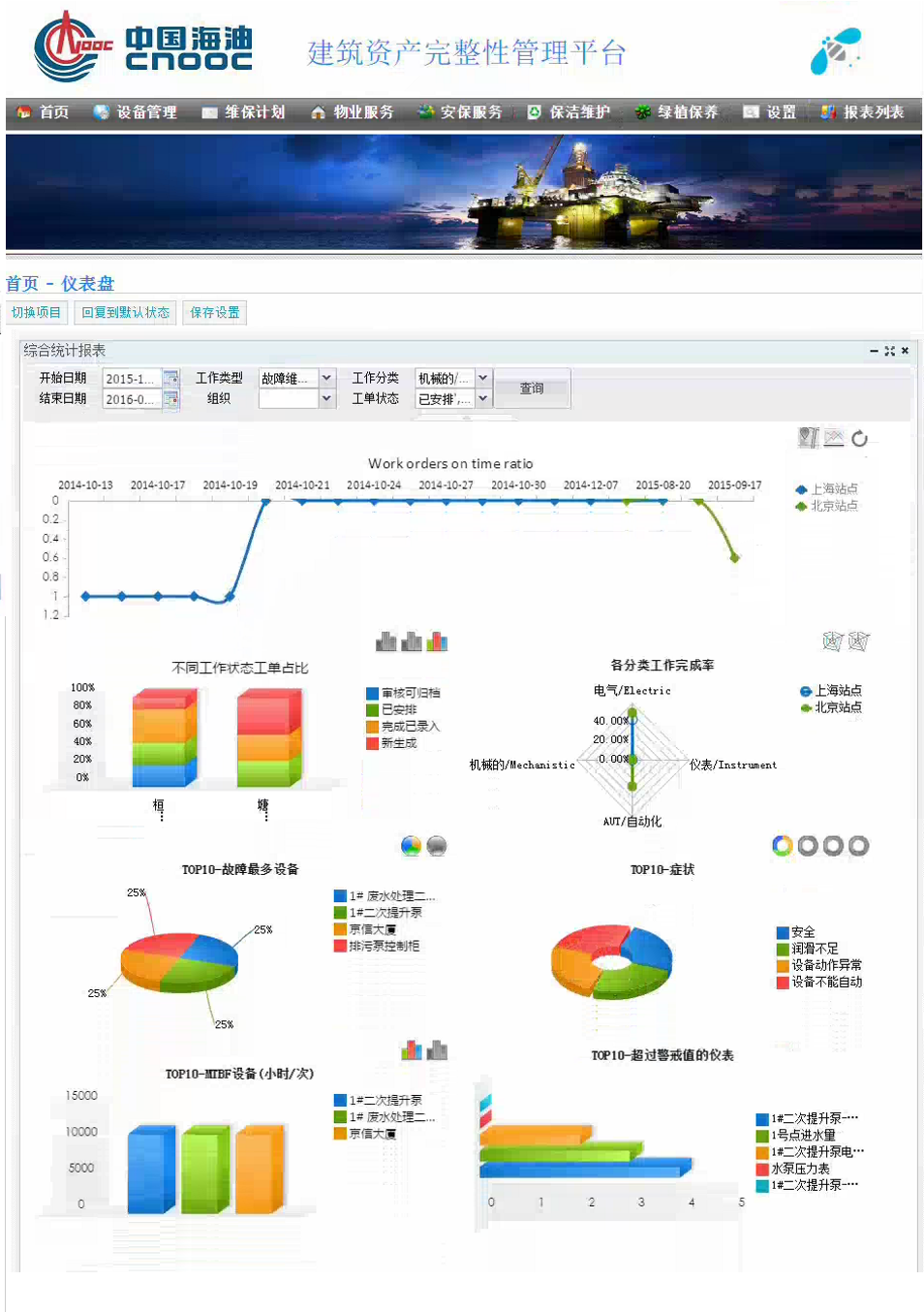BIM for building asset integrity management

The article has been originally published in Electronic Technology & Software Engineering magazine (电子技术与软件工程杂志) in January 2016.
With the promotion on the “Smart City” concept, all walks of life put forward their own version of “Smart”. China National Offshore Oil Corporation (“CNOOC”, www.cnooc.com.cn), as one of the three major oil companies in China, has established a dedicated office to manage the integrity of equipment and facilities, and had proposed the concept of “Smart Offshore Oil” based on the digital management on the full lifecycle of equipment and facilities. In addition to oil production facilities, CNOOC manages a growing real estate portfolio, for which scientific methods should be applied to ensure effective maintenance, safety management and property services during the life of the facilities.
CNOOC has already used BIM as a support tool for the building design and construction phases. BIM (Building Information Modeling), based on 3D digital technology, simulates the actual building and shows relevant project information in detail. Although BIM can display all the different structural levels of the facilities and the data model in a graphical form, its utilization is usually limited to architectural design. Once the building design is confirmed, and after completion, the question remains of maintaining the facilities during its operation phase.
For example, in daily operation, it is easy for the building supervisor to find an equipment by searching its name or through the equipment tree in the BIM system, but if he wants to create a maintenance work order or a preventive maintenance plan for this equipment, he will find that the BIM model does not contain much useful information. The problem is that, although the BIM includes a large amount of building structural data, it lacks information relevant to operation and maintenance.
Consequently, CNOOC proposed to study “The development of the building assets integrity management platform based on BIM data” and selected the bluebee® cloud platform with BIM integration. This integrated platform can provide many functions such as a central web portal, facilities and equipment structure, contract management, work management, work recording, integration with other systems and so on, making up for the deficiency of the BIM database in terms of operational data in BIM database and meeting CNOOC’s demands for daily operation.
Make full use of BIM data
Benefit from a powerful integration tool, bluebee® cloud allows users to access all facility operation and maintenance data from the 3D viewer embedded in the bluebee® portal. In the BIM viewer, users can access and create maintenance information such as contracts, documents, drawings through a menu. The integration enables effective creation and assignment of maintenance work orders. For example, by clicking on a specific equipment in the BIM viewer, the technician can view all cabling and other information from the electrical layers of the model, in order to prepare relevant work permits.
From another point of view, the platform can also be used as a working instruction manual to assist technical workers to prepare before work execution.

Easy to find and retrieve documents related to assets
Searching documents can be a daunting task in daily operation, i.e. it is not only time consuming but also prone to error for a supervisor to search in a lot of paper documents when looking for a specific drawing.
The document management function of bluebee® cloud allows adding documents, drawings, etc. as annex to the relevant equipment so that users can easily find the digital document and greatly save the time spent searching for asset documents.
Visually check operational status and get information in time
Users can check the status of the building facilities in real time through viewing the standard management report of bluebee® cloud, including Top 5 equipment with the most failure time, work order finish rate of each job type and Top 10 symptoms, etc. By clicking on the diagrams, reports allow users to access detailed information e.g. to view incidents contributing most maintenance working time for a piece of equipment or to assign a new preventive maintenance task to the equipment with the highest failure time.

Based on this comprehensive building database, the supervisor is able to visualize the operational status of its assets in real time.
Providing guidance for future equipment purchases and maintenance plans
Thanks to the integrated reporting tool, the system provides spare parts consumption statistics, linked to all daily maintenance information related to equipment and facilities. Combined with other statistical reports available in the platform, the system provides support to forecast procurement needs based on equipment history and maintenance plan.
Within the “Smart Offshore Oil” framework proposed by CNOOC, with “Digital Oilfield”, “Digital Refineries”, “Digital Building” has also become a dynamic part of ”Digital Offshore Oil”: BIM has opened a new large markets for the digital management on building assets.
The development of the Asset Integrity Management platform, with independently-owned Intellectual property rights, can be applied as a product for the management of various buildings assets.
In this project, CNOOC’s first application of BIM technology in the property management industry, the effective integration of a large amount of digital information from architectural design stage and making all this building information directly available, provides an effective tool to achieve visual management on building assets.
The BIM data is used in building services and operation, in a centralized platform for display and management, to create a visual Asset Integrity Management platform.




